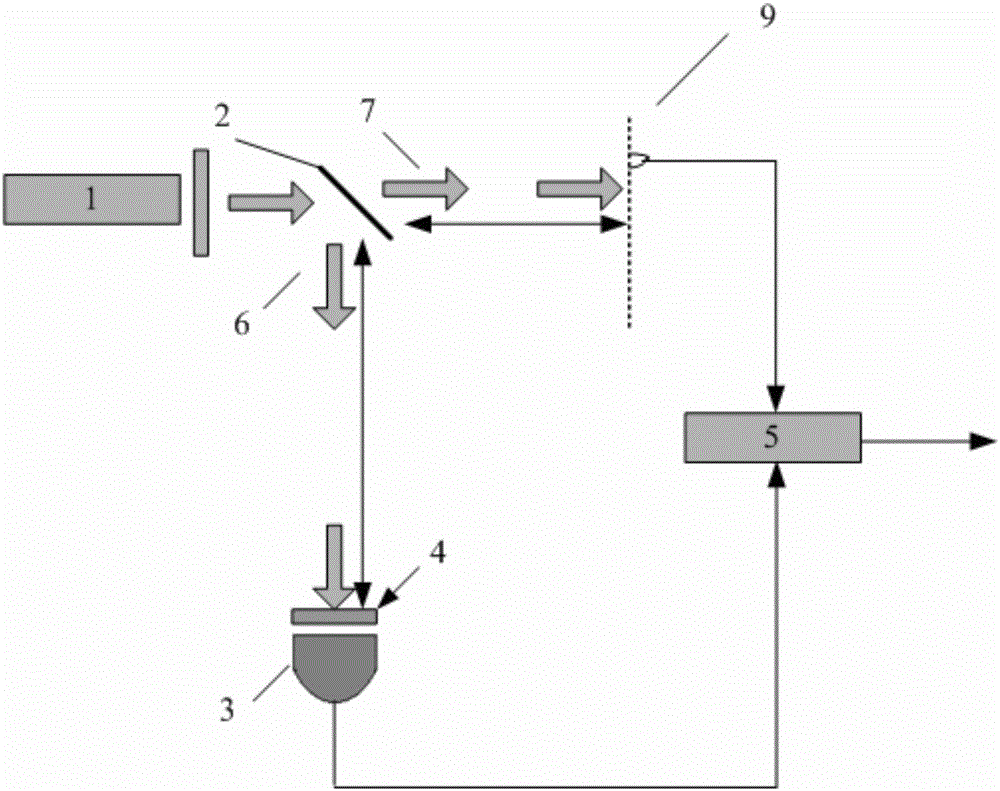Underwater target detecting device based on ghost imaging calculation principle
An underwater target and ghost imaging technology, which is applied in the direction of measuring devices, electromagnetic wave re-radiation, and radio wave measurement systems, can solve problems such as poor imaging quality, low resolution, and weak anti-disturbance performance, and achieve high-quality imaging and resolution High-efficiency, accurate rendering of the effect
- Summary
- Abstract
- Description
- Claims
- Application Information
AI Technical Summary
Problems solved by technology
Method used
Image
Examples
Embodiment 1
[0046] The composition of the computing ghost imaging device according to the present invention is as follows: Figure 4 As shown, including: 1 is a random light source (DMD produced by Texas Instruments), 2 is a beam splitter (Daheng Optical Beam Splitter), and 4 is the object to be imaged (that is, the target object, a double-slit object processed by commission) , 3 is a barrel detector, and the correlator 5 is realized by computer Labview software.
[0047] Target detection method: Under laboratory conditions, a fish tank is used to simulate underwater target detection in the ocean, and a double-slit object is placed in the fish tank. Labview controls DMD to generate 20,000 phase random pictures (pixels are 40×40), that is, random light sources. The random light source passes through the beam splitter and then propagates 80cm underwater to reach the double-slit object, returns to the beam splitter along the original optical path after being reflected by the double-slit obj...
Embodiment 2
[0050] On the basis of Example 1, a surge is produced in an experimental environment, and the experimental environment and parameters are the same as in Example 1.
[0051] Target detection method: On the basis of Example 1, a 24w fish tank wave pump is placed in the fish tank avoiding the propagation path of the light source to simulate underwater target detection under real ocean current dynamics, and the operation method of Example 1 is repeated. The target detection results are as Figure 7 , Figure 8 , the experimental results restore the intensity distribution information of the target object relatively clearly, and can distinguish the double-slit target object more intuitively.
[0052] According to the experimental results, it can be concluded that the present invention is not easily affected by underwater turbulence and has good anti-disturbance characteristics.
Embodiment 3
[0054] With the same experimental conditions as in Example 1, the method of first-order imaging is directly used, that is, an ordinary camera is used to take pictures of the target object, and the experimental light path diagram is as follows Figure 9 As shown in the imaging optical path diagram of an ordinary camera, it includes: 1 is a random light source (DMD produced by Texas Instruments), 2 is a beam splitter (Daheng Optical Beam Splitter), 3 is a barrel detector, 4 is a target object (consigned to process and The double slit object formed), use the fish tank to simulate the underwater environment, utilize the computer Labview software to realize the correlator, and 13 is an ordinary camera. With embodiment 1 experiment environment and condition constant, directly in Figure 9 The double-slit target object is photographed and imaged at the position marked in the imaging light path diagram of the ordinary camera.
[0055] The target detection results show that the first-...
PUM
 Login to View More
Login to View More Abstract
Description
Claims
Application Information
 Login to View More
Login to View More - R&D
- Intellectual Property
- Life Sciences
- Materials
- Tech Scout
- Unparalleled Data Quality
- Higher Quality Content
- 60% Fewer Hallucinations
Browse by: Latest US Patents, China's latest patents, Technical Efficacy Thesaurus, Application Domain, Technology Topic, Popular Technical Reports.
© 2025 PatSnap. All rights reserved.Legal|Privacy policy|Modern Slavery Act Transparency Statement|Sitemap|About US| Contact US: help@patsnap.com



